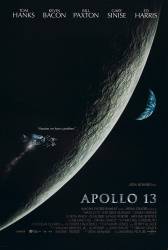Factual error: When Lovell's daughter is complaining that the Beatles have broken up, she slams the album Let It Be into her rack. The scene takes place on the day of the initial explosion aboard Apollo 13, April 13 1970 - immediately prior to the Lovell family attending the screening of a television broadcast from the spacecraft. Let It Be was not released as an album until May 9th, 1970. In April Ringo was still recording drum tracks, not even possible for an advance copy to get out.

Apollo 13 (1995)
Directed by: Ron Howard
Starring: Tom Hanks, Ed Harris, Kevin Bacon, Bill Paxton, Gary Sinise
Factual error: Technician John Aaron states that the damaged ship will need to use "less amps than this" as he points to a vintage 'Mr. Coffee' coffee-maker on his desk. Mr. Coffee was not introduced until 1972.
Factual error: Moments before and during the lift-off of the Saturn V, Ken Mattingly is shown to be watching from a somewhat private grassy field. Wherever he is supposed to be, he is far too close to the launch pad. No unauthorized persons were allowed to be that close, and certainly not in an undisclosed and unsupervised area, not the least of which was for security reasons. The fact that Mattingly is an astronaut would not give him carte blanch to do this, and his training and discipline would prevent his ever attempting doing so in the first place. In reality, Mattingly was in Houston at Mission Control at the time. Otherwise it is a nice shot.

Trivia: The Captain of the Iwo-Jima who Tom Hanks talks to at the end of the movie is the real Apollo 13 astronaut Jim Lovell.
Trivia: The Apollo 13 mission set a record for the greatest distance from Earth ever achieved by mankind. This occurred because unlike the other Apollos, Apollo 13 did not make a burn behind the moon to drop into lunar orbit. The free-return trajectory the mission followed took the spacecraft farther behind the moon than any other mission.
Trivia: The exchange between Lovell and his wife about holidays ("you know that Easter vacation? There's been a change of destination ... how about the moon?") in fact took place in 1968, when Lovell was assigned to Apollo 8 and so missed his planned Christmas vacation.
Gene Kranz: I don't care about what anything was *designed* to do. I care about what it *can* do.
Marilyn Lovell: Naturally, it's 13. Why 13?
Jim Lovell: It comes after 12, hon.
Fred Haise: It hurts when I urinate.
Jim Lovell: Well, you're not getting enough water.
Fred Haise: No, I'm drinkin' my rations, same as you... I think old Swigert gave me the clap. Been pissin' in my relief tube.
Jim Lovell: Well, that'd be a hot one at the debriefing for the flight surgeons... Another first for America's spacemen.
Question: When Aquarius is descending during re-entry, why is the Navy preparing Search & Rescue instead of the Coast Guard?
Answer: Because the Navy was assigned the Search, Rescue and Recovery task for all of NASA's space program. Imagine how long it would take the Coast Guard to get to the other side of the world.
Question: Why did the Apollo 13 spacecraft need a parachute? They were landing on water not solid ground. It's easier to survive a fall when landing on water, so why would they need a parachute if they were landing on water?
Answer: Spacecraft re-enter Earth's atmosphere at extremely high velocity (thousands of miles per hour). Atmospheric friction slows the spacecraft descent somewhat; but, without parachutes, the Apollo spacecraft would still reach the surface traveling at hundreds of miles per hour. Landing in water at such high speed would be like hitting concrete, which would of course be instantly fatal. Hence the necessity of multiple parachutes. The Apollo program (and all early U.S. manned space programs) chose to land in the ocean for two reasons: 1) It was easier to track spacecraft re-entry from horizon-to-horizon at sea without visual and radar obstacles, and; 2) It was faster and easier to position several Navy vessels in the general splashdown location, then deploy helicopters to rapidly retrieve the astronauts and their spacecraft.
Join the mailing list
Separate from membership, this is to get updates about mistakes in recent releases. Addresses are not passed on to any third party, and are used solely for direct communication from this site. You can unsubscribe at any time.
Check out the mistake & trivia books, on Kindle and in paperback.




Chosen answer: Aquarius was most likely going to splashdown in international waters; since the U.S. Coast Guard only has jurisdiction within American waters, the Navy would have to rescue them.
Xofer